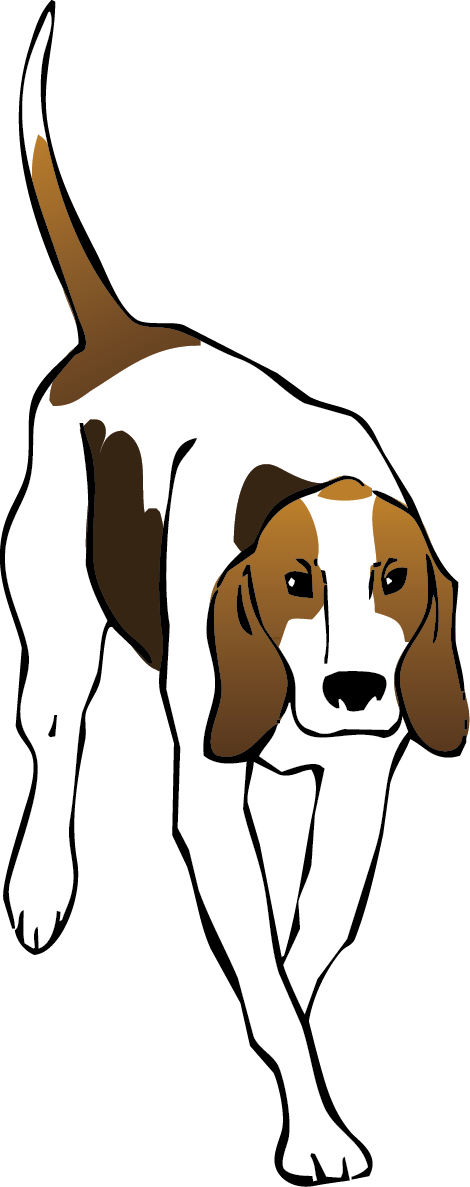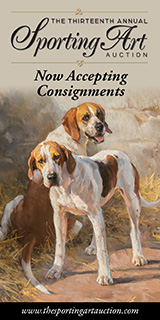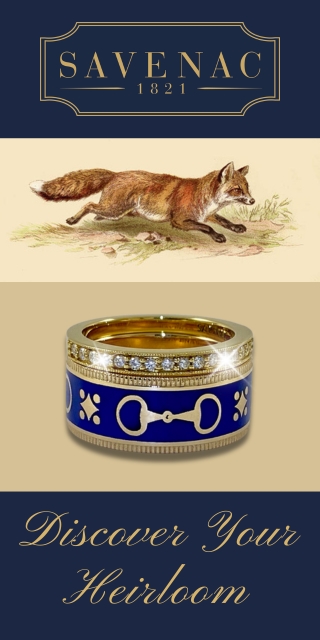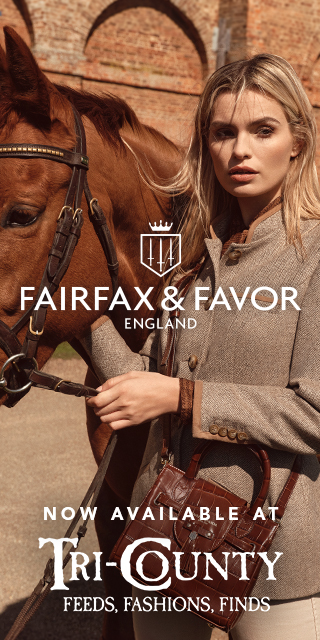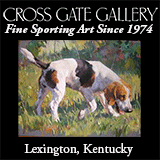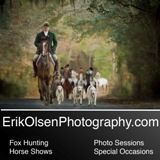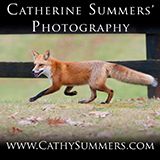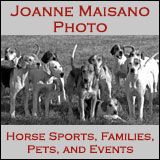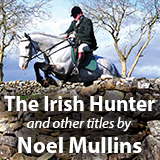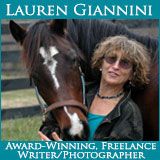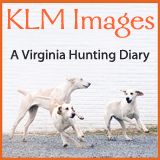Woodford Hounds
Junior Field Hunter Championships: A Big Tree From a Little Acorn
Claire Goff riding Miss Congeniality was judged 1st Field Champion, 13 and over, of the 2016 Junior North American Field Hunter Championships at the finals hosted by the Iroquois Hunt. With Claire are (l-r) Dr. Jack van Nagell, MFH, host, and President of the MFHA; Marion Chungo, organizer; Douglas Wise-Stuart, MFH, Old Dominion Hounds, and co-founder of the event; Cathy Murphy, daughter of the late Pat Murphy, longtime Iroquois huntsman ; and Cindy Goff, Claire's grandmother and former member of the Iroquois field. And the cute dog is Bert! / Betsy Burke Parker photo
Junior foxhunters and their parents traveled from thirteen states to Lexington, Kentucky, where the Iroquois Hunt hosted the finals of the 2016 Junior North American Field Hunter Championships. Thirty-three hunts participated over the course of the informal season by holding qualifying meets from which the finalists were chosen by mounted judges. In thirteen years, the program has grown steadily in participation and geographically from its modest start involving a few hunts in Virginia.
The program is succeeding because it’s purpose rises above just competition. Founders Douglas Wise, MFH, Old Dominion Hounds (VA) and Iona Pillion from the Blue Ridge Hunt (VA) had a larger dream: bring children to new hunting countries, broaden their hunting perspectives, and open their eyes to the fact that these hunting countries don’t just happen to be there for them by chance, but have been nurtured and conserved for the perpetuation of wildlife, open space, and for those who treasure the natural world.
“We want these kids to know what a conservation easement is,” said Marion Chungo, one of the organizers.
Huntsmen On the Move: 2016
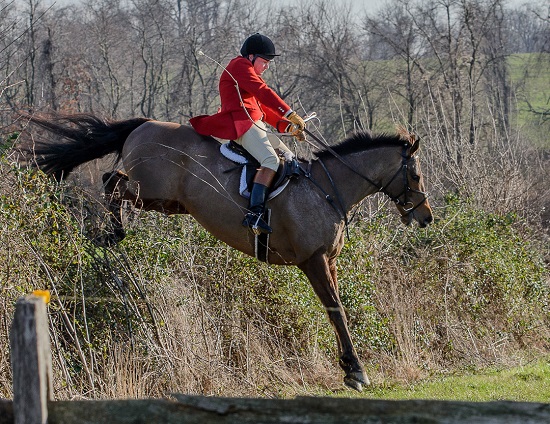 Barry Magner is the new huntsman at Mr. Stewart's Cheshire Foxhounds. / Middleburg Photo
Barry Magner is the new huntsman at Mr. Stewart's Cheshire Foxhounds. / Middleburg Photo
As we approach the 2016/2017 season, Foxhunting Life reports on recent huntsmen moves around the hunting countries.
Round I
Ivan Dowling has retired from hunting Mr. Stewart’s Cheshire Foxhounds (PA). After ten seasons (and before that as first whipper-in), this comes as a major change at Cheshire because the Irish-born Dowling was a key figure in implementing a bold, highly unusual, and successful hound breeding program there. With Dowling’s departure, Cheshire loses a professional whipper-in as well—Stephanie Boyer—who will wed Dowling in September.
Barry Magner is the new Cheshire huntsman. Irish-born Magner’s professional career includes whipping-in at the United Foxhounds (IRE) and a stint whipping-in in England. In the U.S., Magner whipped-in to the Howard County-Iron Bridge Hounds (MD) for a season and became huntsman there in 2007 upon Allen Forney's retirement. He came to Virginia as huntsman for the Middelburg Hunt where he remained for five years until leaving two years ago for Australia. Back in the U.S., Magner joined the Cheshire as professional whipper-in last season and was named huntsman upon Dowling’s retirement.
Junior Field Hunter Championships: More Than a Competition
Heather Feconda, Loudoun-Fairfax Hunt (VA), was Champion, 13 & Over, on Yogi. / Richard Clay photo
The Junior North American Field Hunter Championship competition that began modestly twelve years ago between a handful of geographically-close Virginia hunts continues to expand in scope. This year’s competition involved juniors from twenty-seven hunts located across six MFHA Districts.
The program is succeeding because it’s purpose rises above just competition. Founders Douglas Wise, MFH, Old Dominion Hounds and Iona Pillion from the Blue Ridge Hunt had a larger dream: bring children to new hunting countries and open their eyes to the fact that these playgrounds don’t just happen to be there for them by chance, but have been nurtured and conserved for the perpetuation of wildlife, open space, and for those who treasure the natural world.
“We want these kids to know what a conservation easement is,” said Marion Chungo, one of the organizers.
Drag Hunting Today
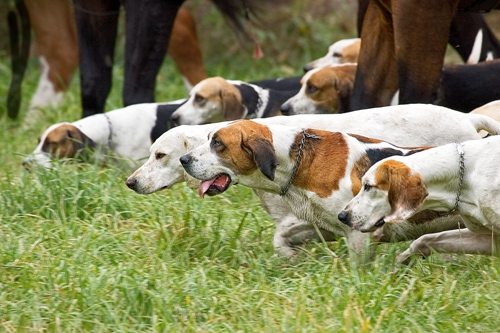 Wayne-DuPage drag hounds head to covert. / Chris Carney photo
Wayne-DuPage drag hounds head to covert. / Chris Carney photo
Drag hunting, according to conventional wisdom, is what a hunt does when its country is constricted by suburban development. Sometimes that’s true, but, more often, hunts follow a dragged line of man-laid scent because the Masters want to. And a few hunts have been doing it for more than a century.
Each type of hunting—live or drag—has its pluses and minuses, depending on the needs and priorities of the participants. Drag hunting offers a controlled hunting experience to the benefit of hounds, riders and landowners. With a judicious laying of the drag, hounds are safer because roads and other hazards can be avoided; farmer’s crops are protected from horse’s hooves; homeowners’ lawns and yards are not trampled; and small pets are safe from the attention of hounds (all assuming that hounds don’t riot).
For riders who seek a gallop over fences, drag hunting offers a more efficient use of time, with no standing on a windy hillside while hounds search a covert for a fox (which may or may not be found). Thus the drag-hunting day typically lasts about two to three hours, with guaranteed galloping and jumping, better suiting those with a busy schedule, rather than the three- to five-hour day usually consumed by the ebb and flow of live hunting.
Passing It On: The Children’s Hunt at Woodford Hounds
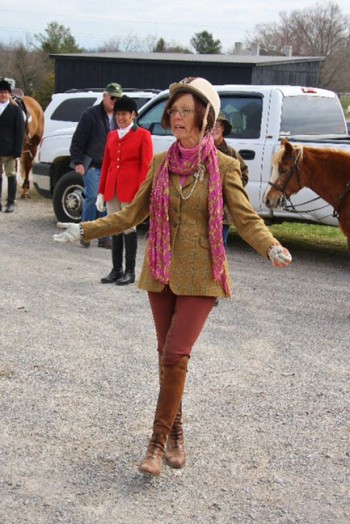 What's wrong with this picture? asks Mary Pierson at the Children's Hunt to test the youngsters' knowledge of proper hunting attire. Master Jane Winegardner (scarlet coat) observes with amusement. / Sive Doyle photoTake a look around your hunt field. If your youngest members are the cute couple in their thirties, foxhunting is in trouble. Unless we share our passion with youngsters, foxhunting will die out when we do.
What's wrong with this picture? asks Mary Pierson at the Children's Hunt to test the youngsters' knowledge of proper hunting attire. Master Jane Winegardner (scarlet coat) observes with amusement. / Sive Doyle photoTake a look around your hunt field. If your youngest members are the cute couple in their thirties, foxhunting is in trouble. Unless we share our passion with youngsters, foxhunting will die out when we do.
It doesn’t take a lot of effort to set the stage for a Children’s Hunt, and you’ll be well-rewarded when you see all the smiles at the end of the day. Michelle Primm was the force behind Woodford’s Children’s Hunt on March 23, 2013. She held well-attended foxhunting camps the past two summers to introduce children to the basics of foxhunting, and a trailer-load of suitable ponies arrived at several meets during the season to take her students out for a day of sport. Wanting to get more kids together at the same time, “Aunt Primm” approached Woodford Masters Robbie Lyons, Jane Winegardner, and Jim FitzGerald with plans for the Children’s Hunt. Woodford Huntsman Glen Westmoreland was all in favor with just one caveat: no lectures!
Gaining Confidence Outside the Comfort Zone with Chris Ryan
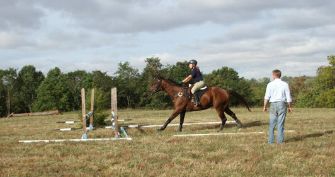 Chris Ryan sets exercises to benefit horses and riders of all levels. / Alys Emson photo
Chris Ryan sets exercises to benefit horses and riders of all levels. / Alys Emson photo
For the second consecutive year, Chris Ryan, MFH of the Scarteen Black and Tans in Ireland crossed the Atlantic to impart some of his knowledge and experience to participants in the Woodford Hounds Hunt Clinic held over the Labor Day weekend at the kennels in Harrodsburg, Kentucky. Chris has been Master of the Scarteen since 1987, and the hounds have been in the trusted care of the Ryan family for over 350 years.
The clinic was held for three days with divisions for the open horse and rider as well as for green horses and for hilltoppers over the three-day period. Overwhelmingly, the results were positive. Chris's teaching style leaves one a more positive, confident rider. He pushes and pushes and gets results. He even had some of the participants jumping wire, after explaining that we must be prepared to jump what is encountered in the hunting field.
The Woodford Hounds and the Shaker Community: A Special Relationship
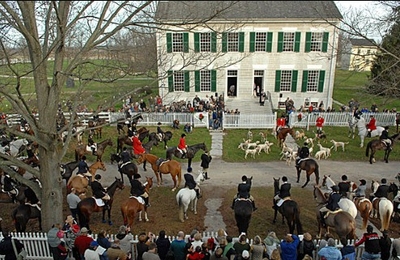 Anne Eberhardt Keogh photo
Anne Eberhardt Keogh photo
The Woodford Hounds (KY) held their Opening Meet on Saturday, November 26, 2011. The Blessing of Hounds was performed at Shaker Village in front of the Center Family Dwelling on Main Street.
The Woodford and Shaker Village enjoy a symbiotic relationship. The hunt kennels and club property share part of Shaker Village's northwestern boundary. Shaker Village very graciously allows us to hunt their more-than 3,000 acres. In turn we keep paths mowed throughout a section of Shaker Village known as Little Texas. We also refer to, promote, and encourage use of Shaker Village's lodging, dining, and stabling to our out-of-town visitors and others. We are a public-relations resource for them.
Chris Ryan Brings the Irish Method to Kentucky
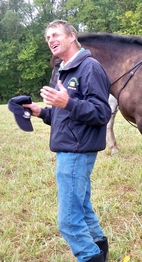 Chris Ryan, MFH and huntsman, Scarteen Foxhounds, Co. Limerick, IrelandFifty riders from four states converged on the Woodford Hounds’ kennels September 3 to 5, 2011 for a foxhunting clinic featuring Chris Ryan, MFH and huntsman of the Scarteen Black and Tans, County Limerick, Ireland. For those who haven’t ridden with Chris, it is a life-altering experience that centers on safety, preparation, and fun.
Chris Ryan, MFH and huntsman, Scarteen Foxhounds, Co. Limerick, IrelandFifty riders from four states converged on the Woodford Hounds’ kennels September 3 to 5, 2011 for a foxhunting clinic featuring Chris Ryan, MFH and huntsman of the Scarteen Black and Tans, County Limerick, Ireland. For those who haven’t ridden with Chris, it is a life-altering experience that centers on safety, preparation, and fun.
Chris taught three levels of riders: those already riding first flight, green but gutsy riders ready to move up, and second flight members wanting to ride more aggressively to follow and enjoy hounds better. Each group practiced many of the same exercises, which were designed to perfect straightness and pace.
